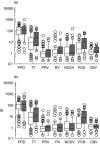Rotavirus-specific T cell responses and cytokine mRNA expression in children with diabetes-associated autoantibodies and type 1 diabetes
- PMID: 16879245
- PMCID: PMC1809689
- DOI: 10.1111/j.1365-2249.2006.03146.x
Rotavirus-specific T cell responses and cytokine mRNA expression in children with diabetes-associated autoantibodies and type 1 diabetes
Abstract
Rotavirus infections have been implicated as a possible trigger of type 1 diabetes. We elucidated this connection by comparing peripheral blood T cell responses to rotavirus between children with newly diagnosed type 1 diabetes (n = 43), healthy children with multiple diabetes-associated autoantibodies (n = 36) and control children carrying human leukocyte antigen (HLA)-conferred susceptibility to type 1 diabetes but without autoantibodies (n = 104). Lymphocyte proliferation assays based on stimulation with an antigen were performed using freshly isolated peripheral blood mononuclear cells (PBMC) and IgG and IgA class rotavirus antibodies were measured using plasma samples collected from the children. The expression of interferon (IFN)-gamma, interleukin (IL)-4, IL-10 and transforming growth factor (TGF)-beta in PBMC was studied with real-time polymerase chain reaction (PCR) in a subgroup of 38 children. No differences were observed in the strength or frequency of positive T cell responses to rotavirus between children with overt diabetes, children with multiple autoantibodies and control children. Children with diabetes-associated autoantibodies had, instead, stronger T cell responses to purified coxsackie B4 virus than control children. Rotavirus-stimulated lymphocytes from autoantibody-positive children produced more IL-4 and phytohaemagglutinin (PHA)-stimulated lymphocytes more IL-4 and IFN-gamma than lymphocytes from control children. PHA-stimulated lymphocytes from children with diabetes also produced more IL-4 and purified protein derivative (PPD)-stimulated lymphocytes less TGF-beta than lymphocytes from autoantibody-negative control children. In conclusion, our lymphocyte proliferation studies did not provide evidence supporting an association between rotavirus infections and the development of type 1 diabetes or diabetes-associated autoantibodies in young children.
Figures


Similar articles
-
T-cell reactivity to insulin peptide A1-12 in children with recently diagnosed type 1 diabetes or multiple beta-cell autoantibodies.J Autoimmun. 2008 Sep;31(2):142-8. doi: 10.1016/j.jaut.2008.04.024. Epub 2008 Jun 18. J Autoimmun. 2008. PMID: 18565729
-
Sublingual immunotherapy in children modulates allergen-induced in vitro expression of cytokine mRNA in PBMC.Allergy. 2006 Oct;61(10):1184-90. doi: 10.1111/j.1398-9995.2006.01206.x. Allergy. 2006. PMID: 16942566 Clinical Trial.
-
Diminished IFN-gamma response to diabetes-associated autoantigens in children at diagnosis and during follow up of type 1 diabetes.Diabetes Metab Res Rev. 2006 Nov-Dec;22(6):462-70. doi: 10.1002/dmrr.639. Diabetes Metab Res Rev. 2006. PMID: 16572494
-
Experiments by nature: lessons on type 1 diabetes.Tissue Antigens. 2014 Jan;83(1):1-9. doi: 10.1111/tan.12280. Tissue Antigens. 2014. PMID: 24355002 Review.
-
NF-κB in type 1 diabetes.Inflamm Allergy Drug Targets. 2011 Jun;10(3):208-17. doi: 10.2174/187152811795564046. Inflamm Allergy Drug Targets. 2011. PMID: 21495968 Review.
Cited by
-
Virus infections in type 1 diabetes.Cold Spring Harb Perspect Med. 2012 Jan;2(1):a007682. doi: 10.1101/cshperspect.a007682. Cold Spring Harb Perspect Med. 2012. PMID: 22315719 Free PMC article. Review.
-
The HLA Region and Autoimmune Disease: Associations and Mechanisms of Action.Curr Genomics. 2007 Nov;8(7):453-65. doi: 10.2174/138920207783591690. Curr Genomics. 2007. PMID: 19412418 Free PMC article.
-
Antibody Cross-Reactivity in Auto-Immune Diseases.Int J Mol Sci. 2023 Sep 2;24(17):13609. doi: 10.3390/ijms241713609. Int J Mol Sci. 2023. PMID: 37686415 Free PMC article. Review.
-
Rotavirus infection.Nat Rev Dis Primers. 2017 Nov 9;3:17083. doi: 10.1038/nrdp.2017.83. Nat Rev Dis Primers. 2017. PMID: 29119972 Free PMC article. Review.
-
Herpes simplex virus type 1 Us3 gene deletion influences toll-like receptor responses in cultured monocytic cells.Virol J. 2008 Nov 21;5:140. doi: 10.1186/1743-422X-5-140. Virol J. 2008. PMID: 19025601 Free PMC article.
References
-
- Gianani R, Eisenbarth GS. The stages of type 1A diabetes: 2005. Immunol Rev. 2005;204:232–49. - PubMed
-
- Onkamo P, Väänänen S, Karvonen M, Tuomilehto J. Worldwide increase in incidence of Type I diabetes − the analysis of the data on published incidence trends. Diabetologia. 1999;42:1395–403. - PubMed
-
- Hermann R, Knip M, Veijola R, et al. Temporal changes in the frequencies of HLA genotypes in patients with Type 1 diabetes − indication of an increased environmental pressure? Diabetologia. 2003;46:420–5. - PubMed
-
- Lammi N, Karvonen M, Tuomilehto J. Do microbes have a causal role in type 1 diabetes? Med Sci Monit. 2005;11:RA63–9. - PubMed
-
- Honeyman MC, Coulson BS, Stone NL, et al. Association between rotavirus infection and pancreatic islet autoimmunity in children at risk of developing type 1 diabetes. Diabetes. 2000;49:1319–24. - PubMed
Publication types
MeSH terms
Substances
LinkOut - more resources
Full Text Sources
Medical
Research Materials
Miscellaneous

